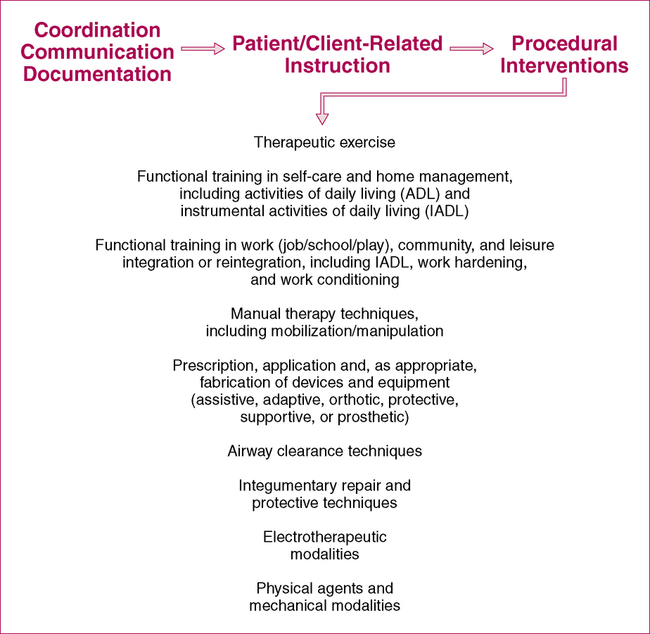In documenting the Plan of Care the PT usually states the proposed frequency and duration of physical therapy visits in addition to a tentative date for reevaluation. The PT then describes the interventions, preferably prioritizing them in descending order. Categorizing the interventions into the three distinct areas outlined by the Guide to Physical Therapist Practice (American Physical Therapy Association, 2001) can help organize this section (Figure 11-1). These three categories are (1) coordination, communication, and documentation, (2) patient-related instruction, and (3) interventions. This categorization, while not required, is useful because therapists often focus exclusively on describing the procedural interventions and minimize or even omit interventions involving coordination of care, communication with individuals involved in the patient’s care, and patient-related instruction. Thus listing each of these three categories helps to ensure that all aspects of physical therapy interventions are addressed. Diagnosis and plan of care were discussed with PTA, who met pt. and pt.’s family at the completion of the evaluation. Pt.’s HHA will be instructed in appropriate guarding during standing activities and ambulation to maximize pt.’s safety while facilitating active participation by pt. (PT will) coordinate with John’s SLP re: strategies to maintain upright positioning in W/C, and possible use of adaptive equipment during mealtimes. The Interventions section of the Plan of Care can include a wide variety of interventions ranging from therapeutic exercise to training in self-care skills to airway clearance techniques (see Figure 11-1). First, documentation of interventions should flow logically and systematically from other aspects of the report. For example, if stair climbing is identified as an activity limitation and improved speed and efficiency in stair climbing is listed as an activity goal, then part of the intervention would logically entail training in stair-climbing skills (Case Examples 11-1 and 11-2). Sometimes, however, the justification for physical therapy interventions is not so readily apparent. For example, therapists use electrotherapeutic modalities for many different reasons, including muscle reeducation and reduction of swelling. When the purpose for using a particular intervention is not clear, the therapist must take the time to document in the report a concise rationale for the intervention chosen. For example:
Documenting the Plan of Care
Components of the Plan of Care
COORDINATION/COMMUNICATION
INTERVENTIONS








